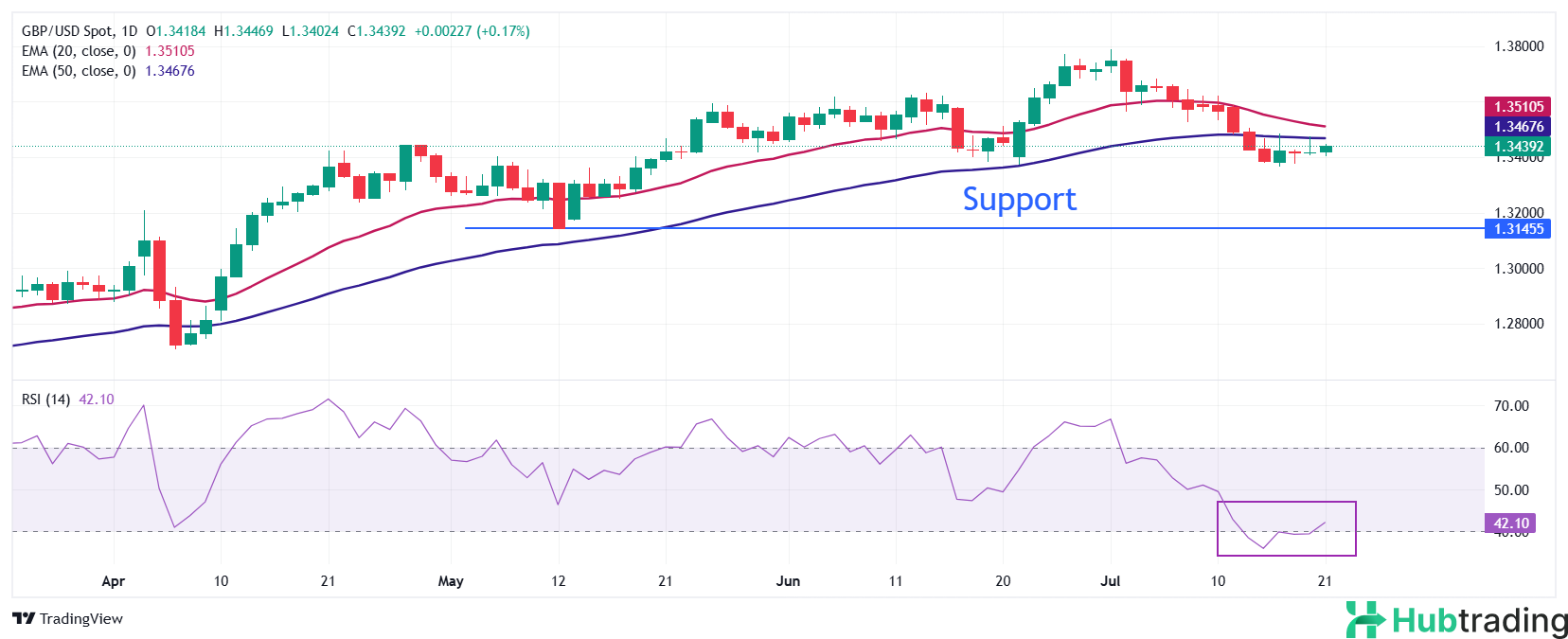-
The Pound Sterling edges up to around 1.3450 against the US Dollar as investors await updates on potential US tariffs.
-
Traders reduce expectations of a dovish Fed stance after June’s US CPI data.
-
The Bank of England is now seen as unlikely to lower interest rates at its September meeting.
The Pound Sterling (GBP) begins the week on a mildly positive trajectory, supported by reduced expectations for interest rate cuts by the Bank of England (BoE) over the remainder of the year.
Market sentiment shifted after the release of stronger-than-anticipated UK Consumer Price Index (CPI) data for June and a less pronounced slowdown in labor market figures for the three months ending in May. These developments have led several major Wall Street firms to revise their BoE outlook.
According to Reuters, analysts at Bank of America (BofA) Global Research, Citigroup, Morgan Stanley, and Goldman Sachs all dialed back their forecasts for a September rate cut by the BoE. Citigroup now anticipates cuts in August, November, and December.
Last week’s CPI report revealed inflationary pressures were higher than expected, with headline and core CPI rising 3.6% and 3.7% year-over-year, respectively. Additionally, the labor data showed that the number of employees on payroll declined less than previously estimated. Revised figures showed only 25,000 layoffs, down significantly from the earlier projection of 109,000.
Looking ahead, investors will focus on the UK’s preliminary S&P Global Purchasing Managers’ Index (PMI) for July and June’s Retail Sales data, due Thursday and Friday, respectively.
Daily Market Movers Digest: Pound Sterling Holds Firm Against the US Dollar
- The Pound Sterling (GBP) trades slightly higher near 1.3450 against the US Dollar (USD) during Monday’s European session, though the overall movement remains broadly sideways. The GBP/USD pair benefits from a mild pullback in the US Dollar, as investors await further clarity on US trade tariff actions ahead of the August 1 deadline.
- At the time of reporting, the US Dollar Index (DXY), which measures the USD against a basket of six major currencies, has slipped to around 98.20. Despite this decline, the index remains close to last week’s four-week peak near 99.00.
- Trade activity continues to influence market sentiment. The US has recently reached agreements with the United Kingdom, Vietnam, Indonesia, and China, and is reportedly nearing a trade deal with India. However, tensions between the US and the European Union (EU) have intensified, with Washington pushing for a minimum tariff of 15% to 20% on Eurozone imports, according to the Financial Times. Additionally, President Donald Trump remains firm on maintaining the 25% tariff on EU automobile imports, a move that could further strain transatlantic trade relations and disrupt global trade flows.
- On the monetary policy front, traders have reduced expectations of a Federal Reserve (Fed) rate cut in September. The probability of a cut has dropped to 58.5%, down from nearly 70% a month earlier, based on the CME FedWatch Tool. This shift follows the release of stronger-than-expected June CPI data in the US, which indicated rising prices for imported goods—largely attributed to recent tariff implementations.
Technical Analysis: GBP/USD Faces Downward Pressure Below Key Averages
The GBP/USD pair continues to fluctuate within Friday’s range, hovering around 1.3440. The near-term trend remains bearish, with prices trading below both the 20-day (1.3510) and 50-day (1.3470) Exponential Moving Averages (EMAs).

Momentum indicators signal cautious sentiment. The 14-day Relative Strength Index (RSI) holds just above the 40.00 threshold, and a drop below this level could trigger fresh bearish momentum.
Key support lies at the May 12 low of 1.3140, while resistance is capped near the July 11 high at 1.3585.





